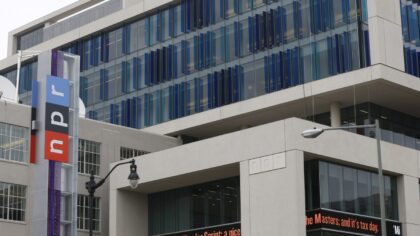The Seattle Times fancies itself the arbiter of truth and justice in our progressive city, but more often than not, it acts as a glorified public relations firm for the most fringe, unhinged elements of the left. The latest exhibit was a masterpiece of journalistic malpractice, turning a handful of sad sacks into a heroic display of activism, all because they can’t stand the thought of Donald Trump as President.
Reading The Seattle Times’ news article about a “Good Trouble Lives On” protest felt like scrolling through a parody of modern journalism. In one breath, they note, “About seven protesters raised upside-down American flags” as they “heed John Lewis’ timeless call for ‘Good Trouble.’”
Then the paper asked us to believe we’re witnessing the next wave of democratic renewal.
Imagine starting your article with: “About seven protesters …” Like that’s some Herculean turnout to be tallied. That’s not a reverent qualifier or hallowed estimation — it’s an admission that you’re writing about a lonely handful of people looking for something to get them out of the house. If your count can be summarized as “about seven,” there’s nothing you can really extrapolate from it. There’s no hidden dramatic tension — you’ve literally documented a few people on a sidewalk with homemade signs. (Note: The Seattle Times posted a photo of the protest. There were only seven people in the shot.)
Moral heroes!
The Seattle Times leans hard into moral framing: Quoting civil rights icons, invoking John Lewis’ “timeless call for good trouble,” and positioning these few as modern-day liberators. But the moment a protest dips under a dozen participants, it ceases to be a notable news event — unless it illustrates how marginal a movement has become.
Yet, The Seattle Times seems determined to act as publicist for a movement it clearly sympathizes with. A seven-person protest is a press-release-level detail, not a front-page showcase.
Reporting on protests is valid when there’s scale, impact, or significance. Why? Because it’s news. What’s the tipping point? Hundreds, thousands—even tens of thousands. Just ask folks who covered genuine uprisings, where police response, public reaction, and elected‑official commentary all create meaningful substance.
But the Times? They treat a handful of activists as if the streets of Seattle are boiling. If the goal was to show a once-vibrant movement now reduced to a sidewalk sideshow, that’d be an honest story. If The Seattle Times had run a headline saying, “Anti-Trump Movement Shrinks to Seven Dedicated Diehards,” that would be news. It would be an accurate, if unflattering, assessment of the situation.
Instead, they coat a pedestrian gathering in “heroism,” call it “activism,” and forget to tell readers why it matters — beyond appealing to their liberal base.
This isn’t journalism. This is The Seattle Times
This isn’t nuanced reporting — it’s cheerleading. When The Seattle Times uses its ink for stunts like this, it isn’t fueling democracy — it’s manipulating it.
The liberal newspaper is pushing narrative over nuance, hoping to dress up a story that wouldn’t meet basic editorial standards at almost any other paper. And all to underscore their contempt for anything that resembles Trump. Their hatred for the man is so profound, so all-consuming, that they will bend over backward, twist logic into a pretzel, and inflate a seven-person gathering into a national movement if it means striking even the faintest blow against him or his supporters.
If seven conservative activists stood on an overpass in Seattle, protesting some progressive policy, would The Seattle Times dispatch a reporter, write a glowing piece about their courage and their “timeless call for good trouble”? Not a chance. They’d probably ignore it entirely, or if they did cover it, it would be framed as an “extremist fringe” gathering, perhaps with a subtle hint about white supremacy or some other loaded accusation. The double standard is so blatant, it’s almost comical – if it weren’t so damaging to the integrity of local journalism.
When your politics dictate your coverage, journalism becomes propaganda. You can almost picture the reporter’s pen quivering with excitement as they craft prose designed to inspire more “good trouble” from their dwindling readership.
Manufacturing news
The role of a newspaper is to report the news, not to create it or to act as a propaganda arm for a political party.
If you can literally count the protesters on your fingers, you likely have no story. At that point, it’s not reporting; it’s puff and marketing. But they just can’t seem to help themselves. It’s a newspaper that Trump broke.
When The Seattle Times takes a pathetic, seven-person protest and transforms it into a heroic display of activism, they aren’t just failing their readers, but actively undermining the public’s trust in media. They’re telling us that their agenda matters more than objective reality. And that is the real “trouble” we should be talking about. And it’s not “good trouble,” either.
Listen to The Jason Rantz Show on weekday afternoons from 3-7 p.m. on KTTH 770 AM (HD Radio 97.3 FM HD-Channel 3). Subscribe to the podcast here. Follow Jason on X, formerly known as Twitter, Instagram and Facebook.
Click this link for the original source of this article.
Author: Jason Rantz
This content is courtesy of, and owned and copyrighted by, https://mynorthwest.com and its author. This content is made available by use of the public RSS feed offered by the host site and is used for educational purposes only. If you are the author or represent the host site and would like this content removed now and in the future, please contact USSANews.com using the email address in the Contact page found in the website menu.











